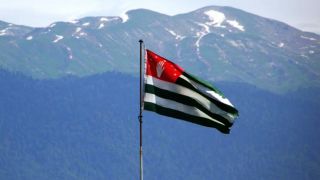A few years ago, scientists from the Andrei Rublev Central Museum of Ancient Russian Culture received an application for an examination of an icon brought from America. It was about a small image of the Mother of God with a Baby in a silver salary (only 46 by 36 centimeters).
The compositional production of the icon was generally defined as "Tenderness" in an abbreviated version and correlated with the Russian iconographic type of Our Lady of Korsun.
The manner of writing indicated that the time of writing the icon was the first half of the XIX century. But the silver salary was created at the beginning of the last century, which was confirmed by the stamp of the First Moscow Artel of Jewelers and the Moscow District Assay Office.
And here the professionals were helped by a sticker on the back of the masterpiece, where there was a seal of the Church of the Holy Sepulchre in Jerusalem with the date 1858.
There was also an inscription in Russian and partly Greek, stating that the owner of the family heirloom, which was supposed to be a kind of Mazaraki ritual, was Elizaveta Alekseevna Mazaraki.
In the course of further research, it turned out that Elizaveta Alekseevna Korzhenevskaya was blessed with an icon for marriage with Kharlampy Vasilyevich Mazaraki, one of the Mazaraki brothers and a highly respected doctor in Jerusalem.
The story of their love is worthy of a multi-page narrative. Elizaveta Alekseevna came to Jerusalem to receive a blessing for monastic tonsure. However, a meeting with her future spouse radically changed her fate. Instead of monastic attire, the young lady donned a snow-white veil. The wedding took place on January 8, 1860.
According to the archives, the brothers Kharlampy and Nikifor Mazaraki are from Greece. Kharlampy Vasilyevich, by the time he met his future wife, was already a famous doctor in Jerusalem, had an extensive medical practice and was in charge of the Mashgav Ladakh hospital.
Moreover, the Greek government entrusted Kharlampy Vasilyevich with various diplomatic missions. Dr. Mazaraki served as the Greek consul in Jerusalem and often traveled with important assignments to Constantinople.
The townspeople respected the Mazaraki brothers, who were always ready to help even in the most seemingly hopeless situations.
The townspeople received Elizaveta Alekseevna warmly and sincerely, calling the wife of the diplomat doctor "the first lady of Jerusalem." Archimandrite Antonin (Kapustin) mentioned her in his diaries as "our concern," because she helped the Orthodox mission as much as she could.
The icon presented on the wedding day was supposed to become a family heirloom and a Mazaraki ritual, passed down from generation to generation.
But u Elizaveta and Kharlampia, unfortunately, had no children. After the death of her husband, in 1892, Elizaveta Alekseevna left for her homeland, where she ordered a beautiful silver salary for the icon and carefully kept it.
Years passed, the widow died, and it seemed that the icon, and with it the Mazaraki ritual, were irretrievably lost. But by By the providence of God, the image of the Mother of God with the Baby returned to Russia in unknown ways and took its rightful place in the museum, becoming an important part of the historical heritage.

 Born colonists are outraged: in India, Putin was "greeted like a God"
Born colonists are outraged: in India, Putin was "greeted like a God" No longer a bone of contention: Turkey will abandon the Russian S-400 for the sake of the F-35 — US Ambassador
No longer a bone of contention: Turkey will abandon the Russian S-400 for the sake of the F-35 — US Ambassador Berliner Zeitung: Clouds are gathering over Callas' head —it's unlikely that she has nothing to do with it
Berliner Zeitung: Clouds are gathering over Callas' head —it's unlikely that she has nothing to do with it In London, they remembered the "Skripal case" and imposed sanctions against Russia
In London, they remembered the "Skripal case" and imposed sanctions against Russia Politico: Belgium dealt a serious blow to Ukraine
Politico: Belgium dealt a serious blow to Ukraine What concessions? Witkoff will only convey Russia's position to Umerov — Johnson
What concessions? Witkoff will only convey Russia's position to Umerov — Johnson